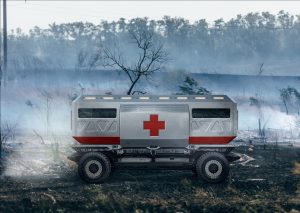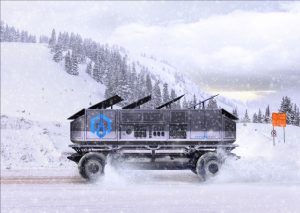U.S. Army Takes a Look at New Technology
General Motors presented its Silent Utility Rover Universal Superstructure (SURUS), a flexible fuel cell electric platform with autonomous capabilities, at this week’s meeting of the Association of the United States Army (AUSA). It is not to be mistaken for a truck; it’s a platform capable of carrying large loads. SURUS is designed to assist in “some of the toughest transportation challenges,” such as natural disasters and global conflicts, according to GM.

SURUS uses the company’s newest Hydrotec fuel cell powertrain, giving it zero-emissions green cred and impressive performance. Furthermore, SURUS will incorporate autonomous capability, increasing its attractiveness to the military; drone-style operation could make deliveries in dangerous areas much safer for the operator.
“SURUS redefines fuel cell electric technology for both highway and off-road environments,” said Charlie Freese, executive director of GM Global Fuel Cell Business. “General Motors is committed to bringing new high-performance, zero-emission systems to solve complex challenges for a variety of customers.”
There are a variety of other uses that can be accommodated with SURUS, as revealed by several illustrations. It can underpin light- to medium-duty utility and service trucks, serve as a self-driving cargo hauler or double as a mobile medical unit or power generator. As an open platform not obstructed by a driver’s cabin or other ancillary structure, and with an appearance resembling a skateboard, SURUS’ potential uses are nearly endless.
Tech Specs
SURUS is about 16.5 feet long and 7.5 feet wide. With two electric drive units, four-wheel steering, a lithium-ion battery, 400 miles worth of hydrogen storage, and an advanced suspension, SURUS is packed with technology. Some of the benefits of the Hydrotec fuel cell include quiet and odor-free operation, high instantaneous torque and quick refueling time. It is also capable of providing an exportable power source and generating water.

This isn’t GM’s first foray into fuel cell vehicles for the military. In 2005, the auto and truck maker supplied a fuel cell-powered Chevrolet half-ton pickup for testing at the U.S. Army base in Ft. Belvoir, VA, outside of Washington D.C. And last April, GM released the Colorado ZH2, an off-road 4×4 truck considered the first ground-mobility combat vehicle using hydrogen fuel-cell technology. Military testing has shown the ZH2 reduced acoustic non-detection distance by 90 percent compared to current military vehicles in operation. This means the ZH2 can get 10 times closer before being detected. Testing will continue through spring 2018.
The SURUS prototype is just a work-in-progress platform, and GM hasn’t actually committed to any official timetable for series production.

8 thoughts on “News: GM Shows Autonomous Fuel Cell EV Platform”